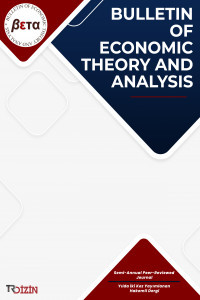Küresel Su Stresi ve Ölçüm Yöntemleri
Su Kıtlığı, Su Stresi, Su Yönetimi, Falkenmark İndeksi, Su Yoksulluğu İndeksi
Global Water Stress and Measurement Methods
___
- Guppy, L. (2014). "The Water Poverty Index in Rural Cambodia and Vietnam: A Holistic Snapshot To İmprove Water Management Planning". Natural Resources Forum, Blackwell Publishing, Vol. 38(3), 203-219, August.
- Hakyemez, C. (2019). Su: Yeni Elmas, TSKB Ekonomik Araştırmalar, İstanbul.
- Lawrence P. , Meigh J., & Sullivan C. (2002). “The Water Poverty Index: An International Comparison”. Keele Economics Research Papers, Keele University.
- Ritchie, H., & Roser, M. (2018). “Water Use and Stress”, Our World in Data, Alınan yer: https://ourworldindata.org/water-use-stress.
- Sullivan C. (2002). “Calculating a Water Poverty Index”. World Development, vol. 30, no. 7, 1195–1210.
- Statista (2022). “Estimated global population from 10,000 BCE to 2100”, Alınan yer: https://www.statista.com/statistics/1006502/global-population-ten-thousand-bc-to-2050/.
- The Economist (2002). “Water Poverty”, Emerging-Market Indicators. December 19, Alınan yer: https://www.economist.com/emerging-market-indicators/2002/12/19/water-poverty.
- UNESCO (2000). “Water Use in the World: Present Situation/Future Needs”. Alınan yer: http:// webworld.unesco.org/water/ihp/publications/waterway/webpc/pag16.html
- UNESCO (2021). The United Nations World Water Development Report 2021: Valuing Water; Facts And Figures. UNESCO World Water Assessment Programme.
- United Nations (2019a). Department of Economic and Social Affairs Population Dynamics. World Population Prospects.
- United Nations (2019b). “UN News Global perspective Human stories, Greta Thunberg tells world leaders ‘you are failing us’, as nations announce fresh climate action”. 23 September 2019, Alınan yer: https://news.un.org/en/story/2019/09/1047052.
- USGS (2018). “Where is Earth’s Water, Water Science School”. USGS Science for a Changing World, June 6, Alınan yer: https://www.usgs.gov/special-topics/water-science-school/science/where-earths-water#:~:text=Notice%20how%20of%20the%20world's,freshwater%20is%20in%20the%20ground.
- Wada, Y., Flörke,M., Hanasaki,N., vd. (2016). “Modeling Global Water Use for the 21st Century: The Water Futures and Solutions (WFaS) Initiative and its Approaches”. Geoscientific Model Development Journal, Volume:9, Issue:1, 175-222,
- WWAP (World Water Assessment Programme) (2012). The United Nations World Water Development Report 4: Managing Water under Uncertainty and Risk. UNESCO, Paris.
- Yayın Aralığı: Yılda 2 Sayı
- Başlangıç: 2016
- Yayıncı: Mehmet SONGUR
Covid-19 Pandemisinin ABD Ekonomisine Yansımaları ve Küresel Ekonomik Güçlükler
Yasemin ÇELİK, İhsan Erdem SOFRACI
Büyüme ve Yolsuzluk İlişkisinin Analizi: Gelişmekte Olan Ülkeler Örneği
İmalat Sanayii Banka Kredileri ile İmalat Sanayii Yİ-ÜFE Arasındaki İlişki: Kredi-Enflasyon Sarmalı
Dünya Ekonomisinde Artan Eşitsizlikler
Küresel Su Stresi ve Ölçüm Yöntemleri
Toplumsal Cinsiyet Temelinde Bütçelemenin Siyasi Boyutu
Gizem Esra KUL, Hilmiye Yasemin ÖZUĞURLU
SSCB’de Plan-Bürokrasi Çatışması: Sovyet Tipi Firma Örgütlenmesi
